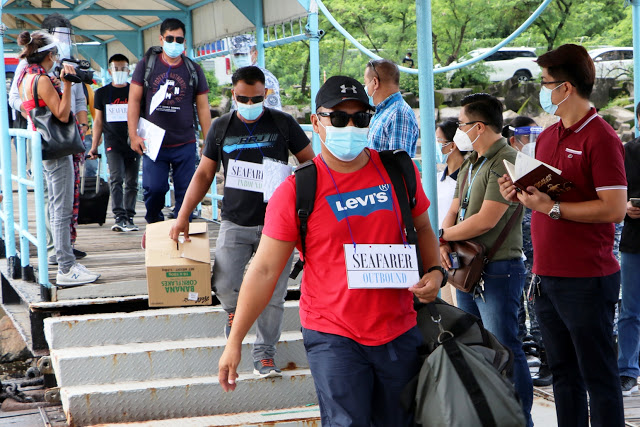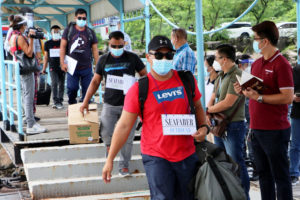

The Department of Transportation (DOTr) has conducted a dry run for the point-to-point embarkation and debarkation of seafarers in preparation for a proposal to activate the Port of Subic as a crew-change hub.
This is part of a project that seeks to facilitate the speedy and safe travel of seafarers and the safe and swift change of crew during the coronavirus disease (COVID-19) pandemic.
Held on August 14 at the Subic Bay International Airport (SBIA) complex, the practice run involved departure and arrival procedures at the former Hanjin ferry landing near the airport, using tugboats to transport the crew to and from ships at anchorage.
The more complex arrival procedure was simulated at the Subic airport terminal. Here new arrivals underwent the required swab test, had their documents processed at a one-stop shop, and proceeded to a mandatory quarantine facility.
The Inter-Agency Task Force for the Management of Emerging Infectious Disease (IATF) earlier approved DOTr’s proposal to dedicate Subic port and other ports as hubs for international crew change.
READ: Subic designated hub for international crew change
The Philippines is one of 13 countries which earlier committed to the International Maritime Organization (IMO) to facilitate crew changes and achieve key worker designation for seafarers.
IMO noted this “represents significant progress to help resolve a growing crisis facing the maritime industry, and enable hundreds of thousands of stranded seafarers to go home or join ships.”
In a joint statement, representatives from 13 countries have expressed deep concern about the current manpower crisis and acknowledged that “the inability of ship operators worldwide to conduct ship’s crew changes is the single most pressing maritime operational challenge to the safe and efficient movement of global trade.”
At the test run, DOTr officials assured that the procedures were safe and that the crew-change protocols being implemented were the best practices in the maritime sector.
“The system we are implementing has incorporated lessons we have learned from earlier activities,” Transportation assistant secretary for communications and commuter affairs Narciso Vingson said.
“During the mass repatriation of seafarers from cruise ships, there were steps that have already been corrected to ensure that health will not be compromised—for the workers and the seafarers. To be able to check this, we have involved all parties, national and local government and agencies,” Vingson added.
On her part, Subic Bay Metropolitan Authority (SBMA) chairman and administrator Wilma T. Eisma said Subic is willing to host the crew-change hub project, but stressed that safety measures should be in place in all phases of the project.
She also insisted that local government units (LGUs) be consulted in all aspects because workers who would man crew-change facilities would be coming from communities near Subic.
The SBMA board of directors has so far approved only the first phase of the project, which involves the point-to-point embarkation of seafarers, said Eisma. The second phase, which involves the quarantining of arriving crewmen in hotels within the Subic Bay Freeport Zone, is still for local consensus.
DOTr undersecretary Raul Del Rosario pointed out that during the dry run, the one-stop-shop system did not allow direct exposure between seafarers and the processors from the Bureau of Quarantine, and that no airport staff was directly involved in the crew-change operation.
Regarding phase two, the safety requirements of LGUs “can be met easily because they have already been included in the protocols,” added Del Rosario, who is also Office for Transportation Security administrator.
“All hotel workers will be housed. They will be quarantined for 14 days before being allowed to go home,” he said.
And to ensure crew-change operations are transparent, Del Rosario said that LGUs will be represented in the one-stop-shop monitoring team, and that the team will be given updates and reports on a regular basis.
Activation of Subic as a crew-change hub is a national government undertaking led by the DOTr and supported by the Department of Health, Department of Labor and Employment, Department of Interior and Local Government, SBMA, and other government agencies.
The project seeks to implement the so-called Philippine Green Lane to facilitate the speedy and safe travel of seafarers, including their safe and swift crew change during the pandemic.




